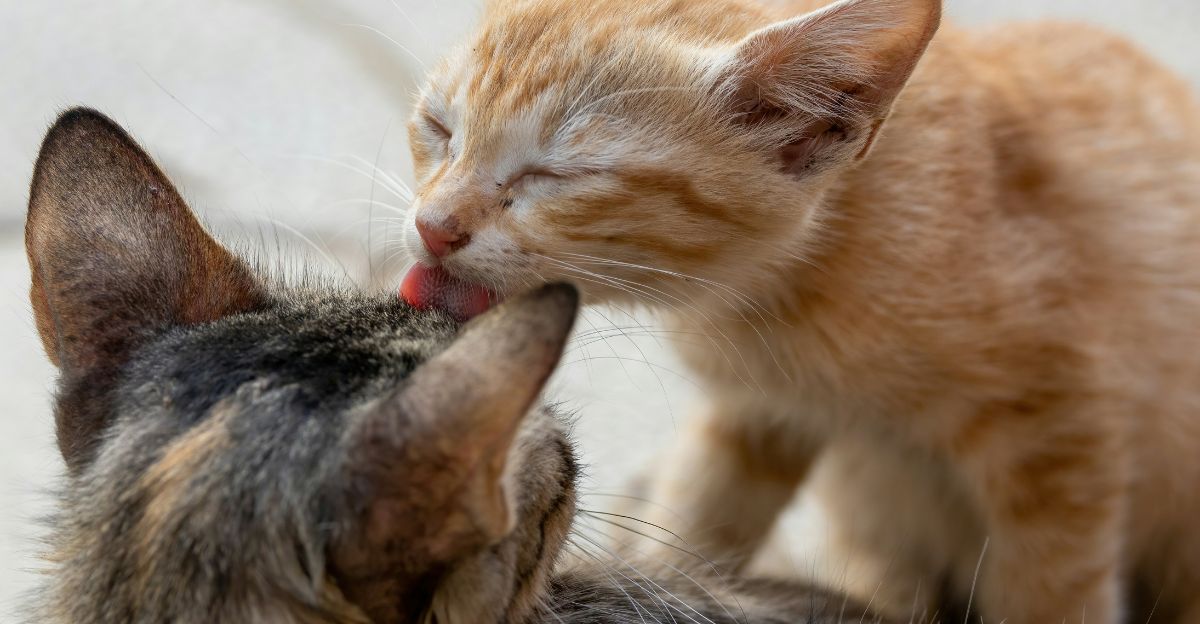Why Do Cats Groom Each Other? The Truth Behind This Sweet (and Sometimes Strategic) Behavior

If you’ve ever seen two cats licking each other’s faces, ears, or necks, you’ve probably wondered: "Why do cats groom each other?" Is it affection? Dominance? Hygiene?
Short answer: It’s all of the above. What looks like a tender moment is actually a mix of feline bonding, caregiving, communication, and sometimes even quiet competition.
Understanding this instinctive behavior—called allogrooming—can help you better interpret your cats' relationships and even make your own grooming routine easier and more meaningful.
What Is Allogrooming—and Why Do Cats Do It?
Allogrooming refers to social grooming between cats (and sometimes humans), where one cat licks another in specific areas like the head, neck, and ears.
This behavior serves multiple purposes:
|
Purpose |
Explanation |
|
Bonding |
Strengthens emotional connections between cats in the same social group |
|
Cleaning |
Helps remove dirt and debris from hard-to-reach spots |
|
Hierarchy |
Often reflects social rank—dominant cats tend to groom others more |
|
Stress Relief |
Releases tension and reduces anxiety within a multi-cat household |
|
Motherly Instinct |
Originates from mother cats grooming kittens for care and protection |
In short, grooming is your cat’s way of saying: "We’re family."
Is Cat Grooming Always Affectionate?
Mostly, yes—but not always.
Cats groom each other to show trust, especially when they focus on sensitive areas like the face. However, allogrooming can sometimes be tactical or even territorial.
You Might See:
● One cat always initiating the grooming
● Grooming followed by sudden fighting or play
● Grooming limited to certain areas
If grooming ends in a squabble, it doesn’t mean they don’t get along. One cat may simply be overstimulated or trying to establish boundaries.
What Does It Mean When Cats Groom Then Fight?
This common phenomenon has several explanations:
|
Behavior |
Likely Meaning |
|
Grooming starts calmly, ends in a bite or chase |
Overstimulation or redirected play |
|
One cat forces grooming |
Power move, asserting social dominance |
|
Grooming alternates between cats |
Balanced bond, mutual trust |
Feline grooming can quickly flip into feline drama. Watch body language: tail twitching, ears flattening, or stiff posture are signs it’s time for a break.
Should I Worry If My Cats Never Groom Each Other?
Not necessarily. While many bonded cats groom each other, some express affection differently:
● Sleeping close together
● Playing or eating near each other
● Following each other around the house
Absence of grooming doesn’t always mean lack of bond—just different love languages.
If they avoid or hiss at each other, that’s when it might be time to assess compatibility or reduce household tension.
How Can You Support Healthy Grooming Behavior at Home?
Whether your cats groom each other or not, you can foster a stronger bond by incorporating gentle grooming into your daily routine.
Try This:
● Use a quiet, calming tool like the Furgo
● Brush daily in a cozy, low-stress environment
● Let your cats sniff and approve the tool before grooming
● Use light misting to soften fur and reduce static or tugging
Grooming with the Misty Spray Comb can feel just as good as being groomed by a fellow feline—and strengthens your bond, too.
Final Thoughts: Grooming Is Language, Connection, and Care
So, why do cats groom each other?
Because it feels good. Because it means trust. Because it mirrors the bond they had with their mother, and now with each other.And with the right grooming tools, you can be part of that bond too.
Try the Furgo and turn brushing into something your cat looks forward to—not flees from.
🐾 Frequently Asked Questions
Q: Why do cats groom each other on the head and neck?
A: Cats groom each other’s head and neck because these are hard-to-reach areas during self-grooming. It’s also a strong signal of trust and social bonding, often seen among cats that consider each other part of the same “family unit.”
Q: Is it normal for cats to groom each other and then suddenly fight?
A: Yes. Grooming followed by play-fighting or sudden aggression can happen due to overstimulation or a shift in mood. Watch for signs like tail flicking or flattened ears, which indicate the cat has had enough.
Q: Does cat grooming each other mean they’re bonded?
A: Usually, yes. Mutual grooming—or allogrooming—is a sign of a close social bond. It’s how cats express affection, reinforce group hierarchy, and maintain harmony within their social circle.
Q: What does it mean if only one cat does all the grooming?
A: If one cat is consistently the groomer, it may indicate a caregiving role or dominance. This behavior is often seen in bonded pairs where one cat takes on a nurturing or leadership role.
Q: Should I worry if my cats don’t groom each other?
A: Not necessarily. Some bonded cats express affection in other ways, like sleeping together or following each other. Lack of grooming doesn’t always mean lack of bonding—just a different feline “love language.”